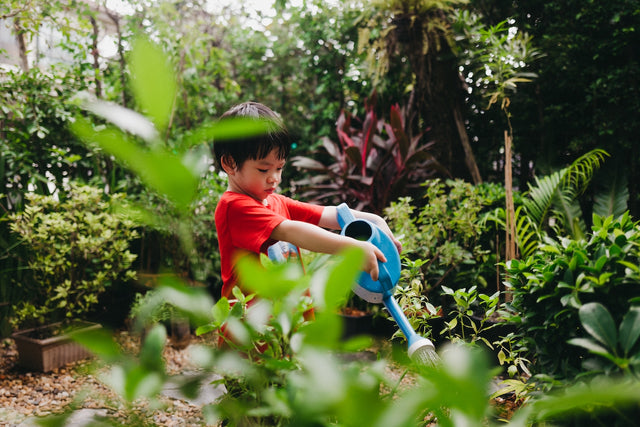8 Ways to Start Gardening With Kids

Spring has sprung, and there’s no better way to enjoy nature with your family than by planting a little garden. Kids are naturally curious, and no matter how little, there are lots of ways they can pitch in with plant care. From seed selection to potting and watering—and especially when it comes time to put flowers in a vase or fruit on a plate—let your little helpers in on the joy and wonder that comes with watching a garden grow.
There are so many child-friendly resources online and at your local library, but a trip to a nearby gardening center is just as good a place to start. Look around, find the answers to your children’s questions, and get to work. It’s okay if not every gardening project comes to fruition; you will learn together what works best for your climate and family.
Most importantly, have fun and don’t give up. Whether you’re working with a window box or a big backyard, there is joy, bonding, and plenty of learning ahead for you and your children in the garden this spring. Here’s how to get started gardening with kids!
Read about gardening together.
Books are the best place to plant the seeds for a new endeavor, especially with kids. Check some gardening books for children out of your local library or purchase a few that are relevant to the type of gardening they’d like to do. Read together in the week or two leading up to your gardening project. This will not only boost excitement, but it can help you make more informed decisions about what types of plants to look into and when’s the best time to plant them. You might also get inspired to dabble in a type of plant you hadn’t thought of yet!
Start small.
Gardening with children is most rewarding when you they can see a little success. The best way is to start is small, so you won’t get overwhelmed and neither will they. A little corner of the yard or even a windowsill planter indoors will do just fine! Tending a tiny garden can lead to big things—one day at a time!
Personalize your plot.
Like with most new experiences for children, they’re more likely to enjoy the process and stick with it if they make it their own. Encourage them to paint rocks that can be used to delineate their new garden area outside, or break out the popsicle sticks, markers, and stickers as tools for decorating their indoor box or planter.
Let your kids have a say in what to grow.
Do you want to have bouquets of blooms…or a bounty of fruits and herbs? Let your child weigh in! It’s always nice to grow something that you can eat together, whether that’s as simple as an herb like mint or basil to rinse, rip up, and toss in while making caprese salad, to actual fruits and veggies they can pluck and eat. Some kid-friendly produce options that are easy to grow in the backyard include blackberries, raspberries, strawberries, tomatoes, and cucumbers. Once you get the hang of gardening, you might also consider planting a lemon or cherry tree, which will be a delight.
As far as flowers, there are plenty of high-yield, minimal-effort varieties that the kids will love to tend. Some easy faves include marigolds, morning glories, zinnia, nasturtium, impatiens, sunflowers, geranium, and nigella.
Make a plant care plan together.
Once you know what you’re planting and where to plant it, do some reading and take notes. Look up each plant together to ascertain how much water and sunlight it needs, how to tend to and care for it, pruning instructions, etc. A lot of these tips will be in your gardening book, but you can also look them up online, plant-by-plant.
Create a color-coded schedule or have your little one illustrate it with pictures of each plant you’re growing together. (If your family uses a chore chart, be sure to add watering to the list!) This planning will keep you on track for watering, tending, and checking on growth progress so they can enjoy the fruits of their labor once ready.
Invest in gardening tools for kids.
You can’t get to planting without the right tools! Some gardening tools are inherently kid-friendly, but if they’re smaller and easier to grip and manipulate, your child will master them more efficiently. Check out Target, Amazon, or your local gardening center for child-sized gardening tools to boost their confidence and enjoyment.
Keep your routine.
Growing things takes time and patience; tack up the schedule you made together and check in frequently to make sure you don’t get off course. They’ll need lots of reminders in the early days, but once tending to the garden becomes part of their routine, the kids will probably be the ones doing the reminding!
Enjoy your plants as they grow.
Whether you’re growing fruits or flowers, cucumbers or coriander, gardening yields natural gifts your children will enjoy. It’s one hobby where you can work together to build something and relish in the tangible results of all your hard work.
Create great fanfare the first time you snip a few flowers or herbs from the garden. When preparing a salad with their veggies or serving a bowl of their fruits and berries, use special plates and make sure to snap lots of photos. The memories— and newfound love of gardening—will last well beyond your harvest season.